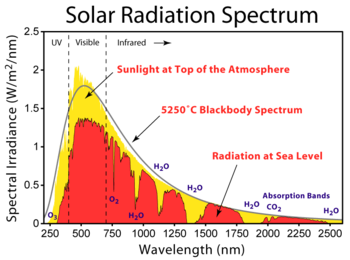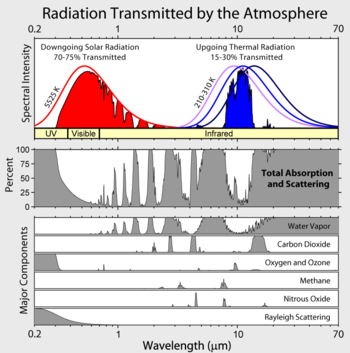RIKLBLOG
|
| Tomorrow |
| 05 Sept. 2007 |
| Yesterday |
| Index |
| Eventide |
| SETI League |
| PriUPS Project |
| Bonus! |
| Contact |
Fun With Mirrors - Part 2
On logical yesterday, we looked into the possibility of using a mirror to "remediate" the energy usage of my Prius. The conclusion was that it's better to paint part of the driveway white. In this case, 30 square metres seemed to be the approximate amount of paint and space needed. I took a quick look at eBay (pay list for striping paint? Are you nuts?) and found that at least one seller had spray cans available, six for $15. These would be enough to cover almost 40 m2, so if one has the space, clearly the cost isn't prohibitive. A 30 m2 mirror would be a lot more money. So far so good.
But this isn't the whole story. The issue of energy used is the one that doesn't seem to get any publicity at all. For instance, you will often read that nuclear power plants emit no carbon dioxide. True! But they still turn uranium into heat. If we're going to be honest about the whole process, we should take this into account. (If we're going to be honest about the whole process, of course, we need to note that the vast, vast majority of energy heating the earth comes from the sun, to the extent that almost all other causes aren't worth calculating.) Which brings us to
The CO2 Question
 Unlike the heat created by burning gasoline, CO2
doesn't create heat at all. Rather, it can be viewed as amplifying
sunlight. Instead of warming the earth directly, it allows the sun
to warm the earth more than it otherwise would by preventing infrared
radiation from escaping into space. Where does this infrared
radiation come from? The sun emits radiation, both infrared and
visible. Much of this energy is contained in the visible range,
as can be seen from
the diagram
at the left.
The visible light is converted to infrared when it is absorbed. In principle,
therefore, painting more of the driveway white, which will
reflect the visible light and hence energy into space, will reduce the
amount of infrared that is available to be absorbed.
Unlike the heat created by burning gasoline, CO2
doesn't create heat at all. Rather, it can be viewed as amplifying
sunlight. Instead of warming the earth directly, it allows the sun
to warm the earth more than it otherwise would by preventing infrared
radiation from escaping into space. Where does this infrared
radiation come from? The sun emits radiation, both infrared and
visible. Much of this energy is contained in the visible range,
as can be seen from
the diagram
at the left.
The visible light is converted to infrared when it is absorbed. In principle,
therefore, painting more of the driveway white, which will
reflect the visible light and hence energy into space, will reduce the
amount of infrared that is available to be absorbed.
There is a conceptual problem with this, however. Painting a fixed portion of the driveway compensates for the annual component of the car's energy use. As long as I continue to commute, that white patch I hypothetically painted in the last blogitem will remediate my heating the planet. However, the CO2 production is cumulative. Every year I add more to the atmosphere. While there are various (complicated) processes of equilibration, they typically exceed the life of the car and perhaps the life of the human driving it. Therefore, I would have to add more white paint every year to compensate for the cumulative addition of carbon dioxide to the atmosphere. Will I run out of driveway before I die? Again I have no idea, and won't 'til I've tried to estimate how much is necessary, which I now proceed to do.
Energy Balance
 Unlike the energy-reflection calculation which is
theoretically simple, calculating how much energy I have to reflect to
compensate for that added by my 4.12 annual tons of CO2
is fraught with uncertainty. There are already a number of IR-absorbing
gases in the atmosphere, including water vapor, methane, and all the CO2
that's already there. All these gases absorb IR at different
altitudes and at different frequencies, some of which overlap. If
you look at the carbon dioxide component (left), you will see that it has three major bands
of absorption. One appears to completely overlap that of water
vapor, and can probably be ignored. Another broad one at about
1500nm largely overlaps water vapor and, based on that fact that IR is
already totally absorbed at this wavelength, can also probably be ignored.
The middle CO2 band, however, looks like it might have some effect,
although it's hard to be certain.*
Unlike the energy-reflection calculation which is
theoretically simple, calculating how much energy I have to reflect to
compensate for that added by my 4.12 annual tons of CO2
is fraught with uncertainty. There are already a number of IR-absorbing
gases in the atmosphere, including water vapor, methane, and all the CO2
that's already there. All these gases absorb IR at different
altitudes and at different frequencies, some of which overlap. If
you look at the carbon dioxide component (left), you will see that it has three major bands
of absorption. One appears to completely overlap that of water
vapor, and can probably be ignored. Another broad one at about
1500nm largely overlaps water vapor and, based on that fact that IR is
already totally absorbed at this wavelength, can also probably be ignored.
The middle CO2 band, however, looks like it might have some effect,
although it's hard to be certain.*
At this point, I'm going to <gasp>do some research on the internet</gasp> to see if someone has already calculated the IR absorption per excess kilogram of CO2. If I have anywhere implied that I'm an expert in atmospheric science, I want to assure you that I'm not. I'm only trying to do order-of-magnitude calculations here. Before I go off on my quest, I'd suggest that you look at the graphs and try to understand them qualitatively.
The Quest
That was fun. All except for where the Frenchmen in the castle kept taunting me about supercritical fluids and enthalpy.
What I Found
Wikipedia says that the present concentration of CO2 has a radiative forcing of 1.5W/m2. I'm going to try to work with that. Right now the CO2 concentration in the atmosphere is 380ppm. Back in 1980 it was 340ppm. Although the forcing isn't a linear function of concentration, it's probably close to linear over a small interval, so it should be fair to say that the annual increase in forcing in a given year is [(2006-1980)/(380-340)]*(1.5/380). That equals .0026W/m2 increase per year. Assuming that's a day and night average, and covers the entire surface of the earth, we square the radius of the earth (6.4 million metres) and multiply by 4*pi. That gives 5.2*1014m2 for the earth's surface area, and 1.35*1012 (1.35 terawatts) increase (per year) of excess power added by CO2. So, it would seem, that for every year that I drive, I have to reflect my share of that 1.35TW back to space, along with all the 1.35TW fractional shares from previous years as well.
Calculating My Share
Checking multiple sources on the web, it seems that about 26 billion metric tonnes are released from fuel burning (of all types) per year worldwide..." (This translates to 29 billion "short tons" to make it commensurate with my previous calculations.) I'm using the "fossil fuel" figure rather than a total including natural sources since implicit in the assumption of increasing atmospheric burden is that it's coming from burning fuels and that natural sources tend to balance each other.
Compare my personal total of 4.12 tons from my Prius to the 26 billion tons of all other anthropogenic sources, and then multiply it by the total 1.35TW of power it's all responsible for and we get 1.35*1012*(4.120/26000000000) = 214 (in Watts), which comes to over 1.9MWh per year. Compare this with the 15MWh from the burning fuel that I calculated yesterday and you can see that the CO2 deposition in the atmosphere accounts for much less than the energy that burning the fuel does. However, it does so cumulatively, i.e., 1.9MWh the first year, 3.8 the next, etc.
Assuming I haven't made an important error or idiotic assumption, this isn't a comforting answer. For one thing, it means that if I decide to remediate the CO2 I may eventually run out of driveway and perhaps I will have to move. For another, it means that one shouldn't ignore the annual contribution of energy from fuel burning since it is the equivalent of several years of CO2 emission, even if it's far less than the CO2 cumulative contribution.. If anything, this would seem to be a splendid argument for being less profligate regardless of our energy source.
My Tom Sawyer Moment
If you have read this far, you may well have come to the conclusion that I'm a climate nut, übergreenie, environmentalist, or someone who embodies great and perhaps excessive angst over the environment, global warming, and, for all I know, beryllium dust from nuclear fission weapons. I am none of the above. In fact, this two-part blog, with its interesting and, I hope, arithmetically-reasonable conclusion, was engendered only by the question first posed: "How big a mirror?" I am working on an even lengthier blogitem about "climate change," which is the proper term for "global warming." If you wonder why there is so much argument and conflict on this issue, just take a close look at the error bars in the enlarged "Radiative Forcing Components" chart. My conclusion about this important subject will be revealed when that blogitem is published, at which point I'll invite you to share my conclusion as your own.
As far as painting the driveway is concerned, I'm not going to do it. There's a simple, practical reason: If the driveway is black, the snow melts faster. I'm hoping that by showing how cheap white striping paint can be, somebody else will paint his own driveway. Preferably someone in the South, where even more energy will be reflected, and where he won't have to deal with snow that refuses to melt as a consequence. Any volunteers?
My Promise
I bet you think I've forgotten or ignored yesterday's promise. Not I! We're still going to have fun with mirrors!
*Please realize that everything I write on this subject is an oversimplification. For example, it doesn't just matter that the IR is absorbed, it matters also at what level of the atmosphere the absorption occurs. This is a subject for specialized discussion and debate by scientists who care a lot more about this than do you or I. And even they don't agree with each other.
NP: "Summer of Love" - The B-52's
| © 2007 |
| Richard Factor |
